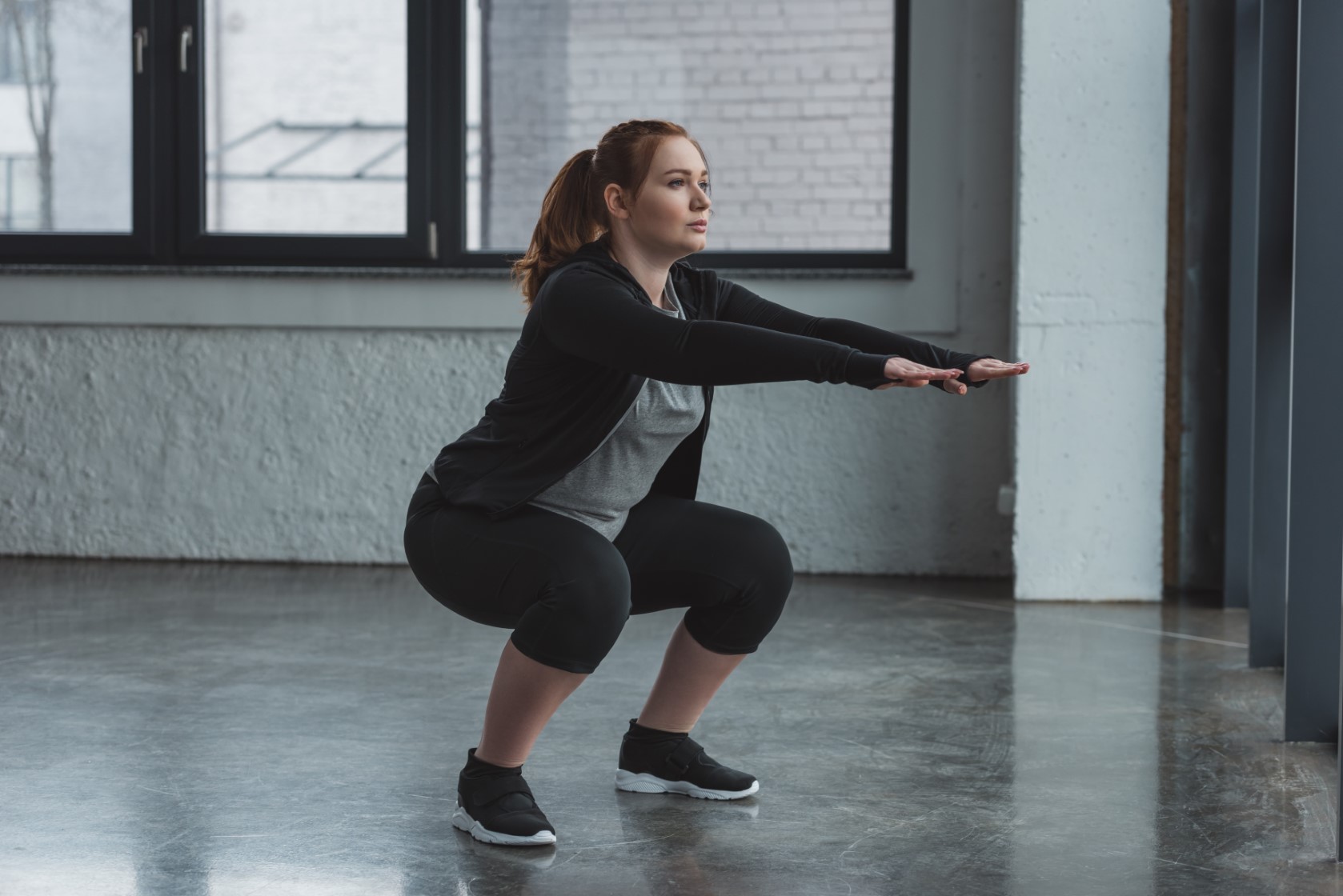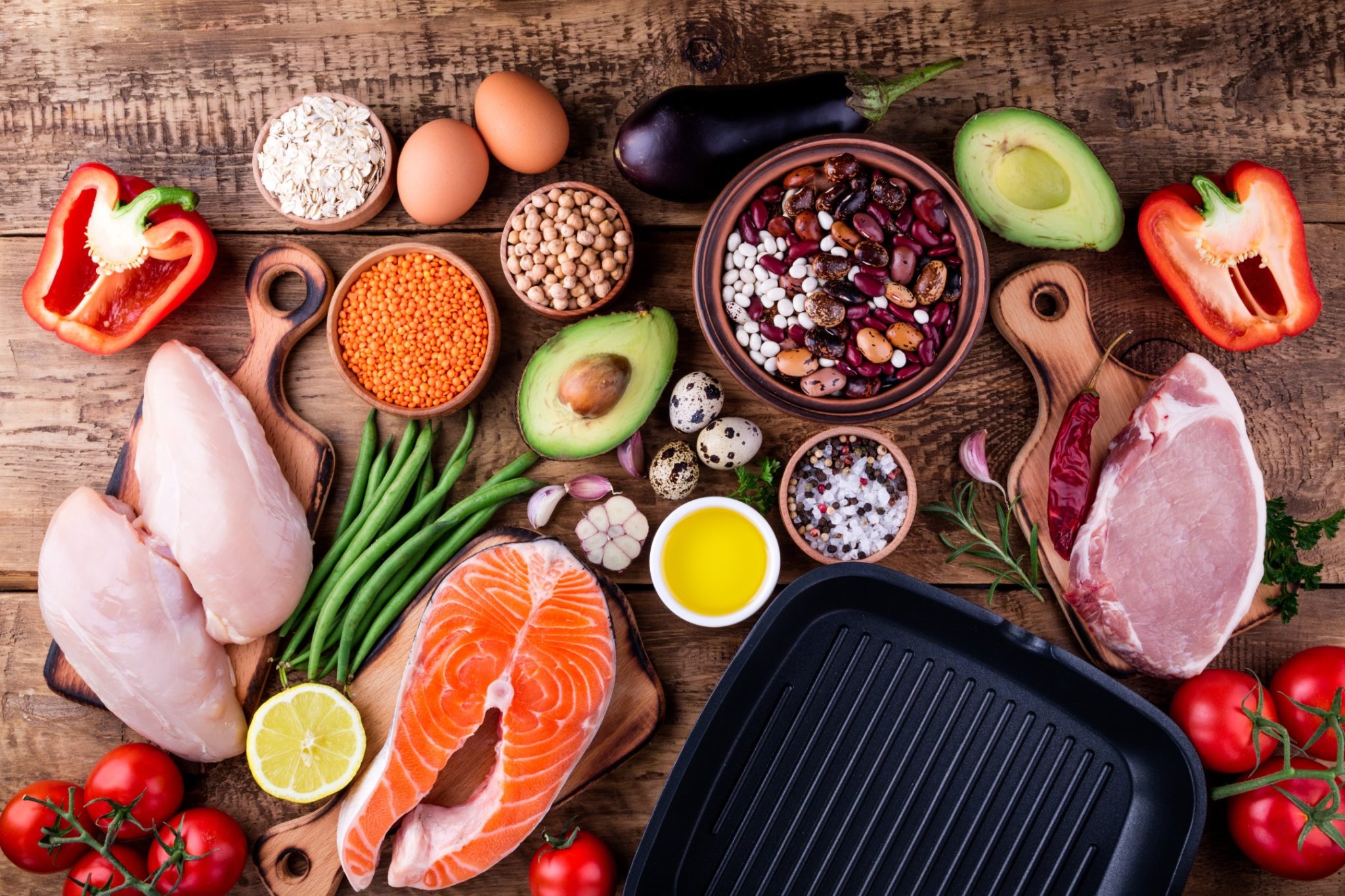I have received dozens of emails from women interested in losing weight with PCOS, but they can’t afford a gym membership, yoga classes, or a personal trainer. Having all of those luxuries would certainly be helpful – I use some of them myself! But the truth is you don’t need them. And you should not wait until you can afford them to start putting your health first. Women who lose weight with PCOS do three very important things:
- Exercise
- Eat a nutrient-dense diet
- Reduce stress
You might be thinking to yourself, “Sounds great, but how do I do all that without hiring a nutritionist, a yoga teacher, and a personal assistant?”
Today, I am going to share 16 actionable tips for losing weight with PCOS that won’t cost you a cent. And I’m going to give you downloadable bonus material that you can use to put these 16 awesome tips into action.
The bonus includes:A handy checklist for all the tips in this postLinks to 6 of my favorite healthy recipesA list of online resources to help you get started
1. Eat without distraction.
Eating while in front of a television, tapping away on a laptop, or driving is not just a choking hazard! People who eat distracted eat more. The American Journal of Clinical Nutrition reviewed 24 different research studies and found that eating while distracted increased overall food intake in most individuals.
Eliminate distracted eating from your life by setting time aside in your schedule to eat. Go ahead and add lunch to your work calendar so that meetings and other responsibilities don’t invade your meal time.
Make it a personal rule to eat at a table and not your desk or the couch where you’ll be tempted to stare at a screen while you eat.
Leave your smartphone in another room during mealtime and, of course, eating at a drive thru is out of the question.
If your day is truly busy, just set aside 10 minutes to drink a healthy super shake. 10 minutes of undistracted eating is better than an hour of distracted overeating!
I’ve seen clients end their battle with overeating just by changing this single habit!
2. Stop scheduling rest days into your workout program.
Wait – doesn’t your body need time to recover from intense exercise?
Yes it does, but you do not need a rest day. You need a recovery workout – a workout where you take the intensity way down and focus on things like joint mobility and deep breathing.
What you don’t need is 2-3 days a week that are devoid of any actual movement. Most of us sit all day at work and then sit in traffic just to come home and sit on our couch. The last thing your body needs is less movement!
On days when you don’t have a cardio or strength session planned, you should still set that block of time aside for health-enhancing activities! On my recovery days, I like to do my usual warm-up followed by a leisurely stroll and then take a few minutes to stretch and foam roll tight muscles. Sometimes I even do some deep breathing exercises.
3. Squat.

The squat is a staple of most exercise programs for good reason. Squats simultaneously work the biggest muscle groups in your body (quads, glutes, back, and core) and are essential to everyday functioning. You use the squatting motion to sit, stand up, and pick things up. You can’t avoid squatting so you might as well get good at it!
How to squat:
- Stand with your feet beneath your shoulders.
- Inhale and lower your body like you’re sitting down in a chair.
- Keep your back neutral, chest up, and core engaged.
- Lower your body until your thighs are at least parallel to the ground.
- Keep your torso stiff as you exhale and press your body back up to standing.
You can do squats with or without added weight, which makes them a great exercise to do at home.
4. Sprinkle on the spice.
Spices are a great way to boost your level of satisfaction from a meal. Human behavior researchers have found that when people have a stronger sensory experience while eating they tend to feel more satisfied and eat less.
Behavioral scientist Jennifer Lee, Ph.D. explains, “Our brains and bodies use a combination of signals to indicate ‘fullness’: sensory signals (taste, smell), gastric signals (full bellies), and nutrient signals (our bodies telling our brains whether we’re lacking in certain vitamins and minerals).”
Plus, many spices deliver some serious health benefits. For example, a study conducted by the US Agricultural Research Service found that type II diabetics who consumed just 1 gram of cinnamon per day experienced a 20% decrease in blood sugar.
Ways to spice up your diet:
- Make several homemade spice blends so that you have them on hand for creative moments in the kitchen. I love to sprinkle this Moroccan spice blend on my quinoa and chickpeas, and this taco spice blend can be added to bland beans or a baked sweet potato for an added kick.
- Sprinkle cinnamon in your coffee or tea each morning.
- Go through you spice cabinet and make sure you have a fresh supply. Ground spices do go bad after a while. As a general rule, whole spices will stay fresh for about 4 years, ground spices for about 3 to 4 years and dried leafy herbs for 1 to 3 years.
5. Sneak more walking into your day.
There are several medical studies which have found that spending too much of your day in a seated position can be hazardous to your health. In fact, a study conducted by the American Cancer Society found that people who sat for more than 6 hours per day increased their risk of death over the next 15 years by 40 percent compared to those who sat for less than 3 hours per day.
Translation: move or you’re killing yourself! Adding more bouts of movement into your day will safeguard your health and make losing weight with PCOS a bit easier.
Some people at your office may take cigarette breaks or quick trips to Starbucks. Why not try taking a quick walking break? The next time you have the urge to get out of your office and grab a mocha, skip the sugary drink and opt for a quick stroll around the block. The fresh air will energize you and the extra steps will further your fitness goals.
If you’re a parent, try walking around the field while waiting for your little leaguer’s practice to finish up. Why sit and wait if you can walk and wait?
6. Make push-ups part of your program.
When it comes to upper body exercises, you can’t beat the push-up. They do a fantastic job of strengthening your upper body while also working your core, glutes, and leg muscles. Push-ups burn calories and build strength.
Many women think they can’t do push-ups. 99% of the time, they are wrong. Push-ups are an intermediate level exercise. If you can’t do them right away, start practicing good form by doing push-ups with your hands on a sturdy bench or the wall.
How To Do Push-Ups:
- Get into a good push-up position: place your hands on the ground slightly wider than shoulders width apart, engage your core to stiffen your torso, keep your feet together and your glutes should be firm.
- Inhale, and lower your chest toward the ground. Keep your glutes and core strong, tuck your elbows close to your sides as you descend.
- Exhale and press back up to the starting position.
- Do as many as you can from your toes. If necessary, you can reduce the difficulty by placing your hands on a bench or the wall.
7. Eat fewer processed carbohydrates.
Every PCOS diet I’ve come across recommends that you get the majority of your carbohydrates from fruits, vegetables, and beans. Unfortunately, the average person tends to get most of their carbohydrates from processed grain products like cereal, pasta, sandwich breads, and sugar.
Getting most of your carbohydrates from these highly refined products leads you to a state of being overfed and undernourished. You’re getting more than enough calories from breads and cookies, but you’re not getting nearly enough vitamins and minerals.
How to eat fewer processed carbohydrates:
- Use lettuce leaves instead of tortillas and wraps.
- Ditch pasta and use spaghetti squash or julienne sliced zucchini instead noodles.
- You can replace white rice with this recipe for cauliflower rice.
- Instead of a bowl of cold cereal for breakfast, try fresh fruit and plain greek yogurt with a little honey. This will also boost your protein intake!
8. Include high-intensity interval training in your cardio program.
High-intensity interval training (HIIT) is a method of cardio exercise that is great for women with PCOS. HIIT workouts can increase your insulin sensitivity, help you build muscle, and improve your body’s ability to burn fat.
A HIIT workout involves alternating low intensity intervals of exercise with intervals of high-intensity exercise. For example, a HIIT workout might include alternating bouts of sprinting with brisk walking. One or two 20-minute sessions of HIIT each week should be enough to boost your weight loss efforts.
Here’s one of my favorite HIIT workout plans.
9. Cook nutritious desserts.

You can lose weight and eat your cake too! The trouble with most traditional desserts is that they are high in calories and low in nutrients.
However, there are plenty of innovative food bloggers who are creating totally nutritious and tasty dessert recipes. Two of my favorite places to find healthy desserts are Chocolate Covered Katie and Purely Twins.
A word or warning: many nutritious dessert recipes are still high in calories, so you need to use portion control.
10. Practice the art of mindful eating.
Mindful Eating is a practice that Buddhist monks have been adhering to for hundreds of years. The concept is simple: bring attention and focus to eating.
Mindful eating has been shown to help chronic overeaters reduce stress and caloric intake. Both of which are helpful in losing weight. Mindful eaters take special care to notice their hunger cues before, during and after a meal. They also savor the sensory experience of eating by reflecting on the taste, appearance, texture, and smell of their food.
Four simple ways to start eating mindfully:
- Eat from a plate or bowl, not a bag. By placing food out on a plate, you get a visual cue as to how much you are eating.
- Put your utensils down in between bites. If you have food in your mouth, your hands should be empty. Take a moment to taste, chew and swallow each bite before taking the next.
- Try to identify each ingredient in a dish. As you eat focus on flavor and take note of what spices and ingredients are present in each bite.
- Throughout your meal contemplate how your food got to your plate. Think about how you cooked it, where you bought it, and the farmer who grew the ingredients.
11. Be aware of liquid calories.
High-calorie beverages tend to be less satiating than a solid food meal of the same amount of calories. In fact, people who drink high-calorie beverages tend to consume more calories in general.
If you want to lose weight, my suggestion is that you drink water, tea, coffee, and the occasional glass of red wine. Here are a few beverages you should keep to a minimum when trying to slim down:Specialty coffee drinksAlcoholic beveragesFruit juiceSoda
12. Get eight hours of sleep each night.
Not getting enough sleep at night is a serious health risk and it can hinder your weight loss efforts. Sleep deprivation can affect the hormones that control your hunger levels. An American Academy of Sleep Medicine research study also found that sleeping less at night may increase the expression of genetic risks for obesity. Many medical studies have found that sleep deprivation reduces fat cells’ ability to respond properly to the hormone insulin.
How to get a good night’s sleep:
- Schedule enough time for you to sleep a full eight hours. This means you need to have the lights off 8.5-9 hours before you’re supposed to get up.Keep your bedroom dark and at a cool temperature.
- Reserve your bedroom for sleeping. Keep the television and computer in other rooms.
- Try to go to bed and wake up at the same time every day.
13. Eat more veggies.

You really can’t eat too many veggies! Vegetables are amazing for so many reasons. But to put it simply, you need to eat more veggies because they have tons of micronutrients and fibers, but are very low in calories. They are the ideal food for weight loss.
How to eat more veggies:
- Learn to cook veggies. Like any food, veggies taste best when you put a little effort into cooking them. You would not expect raw chicken to taste wonderful. The same holds true for asparagus and carrots.Get creative with your salads. Mix salad greens with roasted veggies, fruit, avocados, nuts or seeds.
- Buy produce when it is in-season. Produce will be at it’s best when you buy it at the right time of year. You can look online to get a list of what’s in-season and when for your area.
- Try to eat different color veggies every day. Differently colored veggies contain different nutrients.
14. Work out first thing in the morning.
When you make your workout the first thing on your to-do list, it gets done.
The number one reason women give me for not working out is their busy schedules. And it’s a perfectly valid reason! Unfortunately, if you keep putting other things before your health, your body and your quality of life will pay for it. The easiest way to nip this problem in the bud is to work out first thing in the morning.
- A morning workout may not seem very appealing to those of you that are addicted to the snooze button, but I have a few ways you can make your morning sweat session a cherished ritual.
- Do not check your email when you wake up. Unless you’re a world leader, everybody else’s problems can wait until you’ve worked out.
- Work out at home. Working out at home eliminates commuting time and the need to shower in a locker room – yuck!
- Make a great workout playlist, pick music that energizes you.
- Put the most important part of your workout at the beginning. For example, if your priority is chest and legs, do your squats and push-ups right after your warm-up. This way if you have to cut the workout short, you’ve still accomplished something.
- Be grateful. Having the time, resources, and physical capability to work out is a privilege. Be grateful for that strong, beating heart and your comfy yoga pants!
15. Learn to cook. Even if it’s just six dishes.
In my opinion, cooking is a terrific hobby – especially for women with PCOS. Knowing how to cook will free you from being dependent on restaurants and manufactured food products.
After taking cooking lessons, I found that I prefer my cooking to most cafes and restaurants. More importantly, by cooking my meals, I always have control over the quality of my food.
Think cooking is a chore? Not to worry. You just need to find about five or six healthy recipes you can master. Most people eat the same stuff every week and are perfectly happy to do so.
I recommend you learn the following:
- two poultry dishes
- one fish or seafood dish
- how to roast veggies
- at least one healthy dessert
- one tasty bean or quinoa dish
I include links to my six go-to healthy recipes in the downloadable free bonus!
16. Stop looking for quick fixes.
If you have PCOS, losing weight is about more than just being thin. Managing your weight will help you protect yourself from PCOS-related complications like infertility and diabetes. Lasting, health-preserving weight loss requires you to adopt a lifestyle that makes your health a priority. It is not always an easy thing to do, but the benefits outweigh the costs!
Focus on making small meaningful changes to your lifestyle and eventually the numbers on the scale will reflect the healthy choices you’re making!







